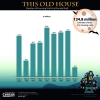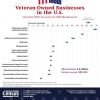Feb122016
Posted at 10:34 AM
Expressing one’s love to another is a celebrated custom on Valentine’s Day. Sweethearts and family members present gifts to one another, such as cards, candy, flowers and other symbols of affection. Opinions differ as to who was the original Valentine, but the most popular theory is that he was a clergyman who was executed for secretly marrying couples in ancient Rome. In A.D. 496, Pope Gelasius I declared Feb. 14 as Valentine Day. Esther Howland, a native of Massachusetts, is given credit for selling the first mass-produced valentine cards in the 1840s. The spirit continues today with even young children exchanging valentine’s cards with their fellow classmates.
Following are a some key statistics compiled by the U.S. Census Bureau in recognition of Valentine's Day.
FLOWERS
14,161
The number of florists’ establishments nationwide in 2013. These businesses employed 62,222 people.
CANDY
1,185
Number of U.S. manufacturing establishments that produced chocolate and cocoa products in 2013, employing 38,717 people. California led the nation with 129 of these establishments, followed by Pennsylvania, with 114.
JEWELRY
23,096
The number of jewelry stores in the United States in 2013. Jewelry stores offer engagement, wedding and other rings to couples of all ages. In February 2013, these stores sold an estimated $2.5 billion in merchandise.
LOOKING FOR LOVE
399
The number of dating service establishments nationwide as of 2012. These establishments, which include Internet dating services, employed 2,348 people.
For more key statistics on Valentine's Day, please see the U.S. Census Bureau Facts for Features.




